Only 11 players with indigenous roots have ever laced up a pair of skates for the Calgary Flames in the 40 years that the team has been in Calgary. During this time, non-indigenous Canadians have made up approximately 75% of the estimated 960 players who played for the team. This means that of all the players ever to don a Flames’ sweater, only 1.5% had aboriginal roots even though First Nations. Metis and Inuit people make up almost 4.9% of the Canadian population.
The Flames can take some solace from the fact that they are slightly better than the NHL in slotting indigenous players into their lineup. By the NHL’s own estimates, only about 85 players of native ancestry have ever played in the league. In percentage terms, that amounts to just over 1% of the 7600 players believed to have played in the league over the course of its century-long history. (from ‘Recasting Pro Hockey’s Indigenous Players,’ New York Times, 25/06/2018)
The NHL is rightly concerned about statistics like these. They say as much about the league’s failings in addressing diversity issues as they do about the racist barriers indigenous hockey players have faced in striving to carve out a place for themselves in the league. Leaving simple justice aside, all of this has deprived the NHL and its fans of seeing great aboriginal hockey talent and hurt the business of hockey.
Flames great Theo Fleury said as much while speaking to a First Nations gathering on the barriers faced by native hockey players – “It’s a damn shame that there are so few First Nations players in the NHL. I see the talent that is out there. The NHL doesn’t have a clue – not a friggin’ clue.”
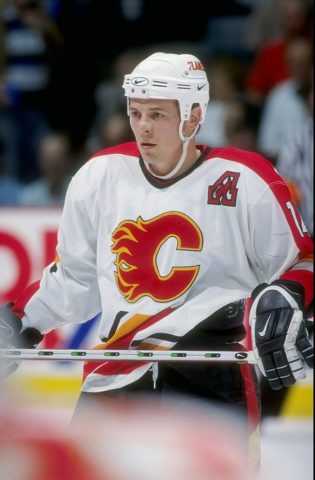
The indigenous population in Canada is growing at a rate four times faster than the Canadian-born, non-indigenous population. Not only that, but it is also younger. From a business standpoint, the NHL cannot continue to ignore Canada’s native peoples. This is doubly true for the Flames – a franchise located in a province where First Nation and Metis people make up 6.5% of the population.
Here’s a look at the 11 indigenous players who have worn the Red since 1980 and what many of them have done to help advance aboriginal hockey in Canada.
Theo Fleury
Saskatchewan-born Fleury is of Metis ancestry. Over 10 seasons from 1988-99, He awed Calgary fans with his explosive offense and pugnacious style. In return, Calgary fans adored him. When the Flames dispatched him to the Colorado Avalanche in 1999, Calgary came to understand the pain that archenemy Edmonton had endured when the Great One left for Los Angeles just over 10 years before.
Since his retirement in 2003, there has been an untold number of stories written about the fiery winger’s exploits on the ice. There’s not much more to add here.
Related – Theo Fleury – It’s the Size of the Heart That Matters
In retirement, Fleury became much more than what he did on the ice. He co-authored a best-selling autobiography, pursued a music career, launched a line of clothing, established a concrete business, owned a junior hockey club, starred on a reality TV show and became the subject of a play and a best-selling biography. He is the recipient of the Canadian Humanitarian Award, the Queen’s Jubilee Medal, the Aboriginal Inspire Award and several honourary degrees for his charitable work.
Fleury is a committed philanthropist working to help victims of sexual abuse as well as chron’s disease and colitis. He also works with the Calgary Flames’ Foundation and the Calgary Dream Centre.
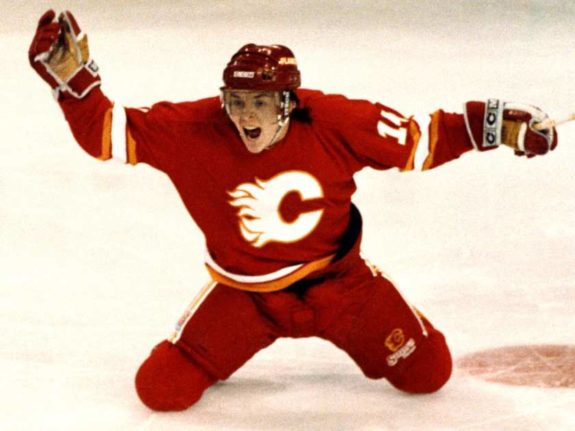
What may be less familiar for many hockey fans is what Fleury has done to promote mental health among First Nations people. He has visited 220 aboriginal communities across Canada, speaking to native youth about trauma, mental health, drug addiction and aboriginal spirituality, which he credits with helping him deal with his own struggles with alcoholism and the aftermath of sexual abuse.
Travis Hamonic
30-year-old Metis Travis Hamonic was born to a farming family in Manitoba. He is a 10-year NHL veteran and has suited up for the last three seasons with the Calgary Flames. The rugged 6-foot-2, 205-pound defenseman, nicknamed “The Hammer,” was until the end of this season a key part of the Flames’ blue line but is now one of the NHL’s most sought after free agents.
The breadth of what Hamonic and his wife Stephanie are doing to help indigenous youth is astounding, given the demands placed on them by Hamonic’s NHL career and a young family. The Hamonics have established the Northern Project Initiative, which brings indigenous kids from the Northwest Territories, Nunavut and Yukon to Calgary to see the Flames play. A related charity is Hammer’s D-Partner Program that invites children who have lost a parent to see Calgary’s home games.
They were also instrumental in establishing the Women in Need Society (WINS), which provides financial and other support to vulnerable women and their children in Calgary. He also helped start “Hit the Ice” – a TV reality show that features young indigenous players from across Canada at an NHL-style training camp led by various NHLers.
Related – Hamonic’s Charities a Big Hit in Calgary
The National Hockey League Players Association (NHLPA) has also recognized Hamonic for his work, as they awarded him the NHL Foundation Player Award for community service in 2017.
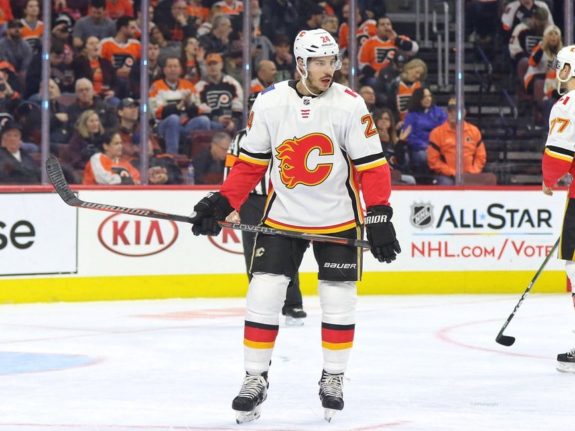
In a 2017 interview, Hamonic explained his commitment to supporting indigenous youth, saying that “My heritage is something that I hold really close to me. Being Metis myself, you want to be able to help. My wife Steph and I decided that was something really important to us to try to help and give back.”
Micheal Ferland
A Cree from Swan River, Manitoba, Ferland spent the better part of four seasons with the Calgary Flames from 2014-18. Now with the Vancouver Canucks, his future with the team is uncertain due to a concussion he suffered in a fight early in the 2019-20 season. (from ‘Patrick Johnston: Micheal Ferland’s Canucks future is up in the air,’ The Province, 10/20/2020)
Related – Canucks’ Micheal Ferland : A Postseason Difference Maker?
The big physical winger was raised by a single mother to whom he says, “he owes everything.” (from ‘Ferland: Helping Kids is One of the Best Feelings in the World,’ Calgary Herald, 10/12/2015) His mother struggled to pay for Ferland’s minor hockey and often turned for help to charities such as KidSport and the Manitoba Metis Foundation.
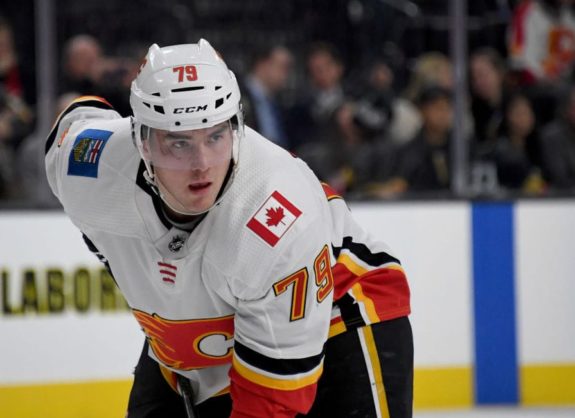
Because Ferland remembers the help he had making his way to the NHL, he tries to “pay it forward,” explaining that while he was in Calgary, he jumped in as often as possible with events organized by the Calgary Flames Foundation.
Rene Bourque
Bourque, who hails from Lac La Biche in northern Alberta, is Metis and spent 12 seasons in the NHL spanning 2005 to 2017. He played for the Flames for three full seasons beginning in the 2008-09 season before the team traded him partway through the 2011-12 season to Montreal. Bourque tallied 20 goals-a-year during his time in Calgary, and that represented the peak of his career.
In his post-playing days, Bourque continues to be active in supporting indigenous youth hockey. The Rene Bourque Hockey Fund donates hockey equipment to indigenous and disadvantaged youngsters, while Bourque’s Buddies gives hockey tickets to children of the Tsuu T’ina Nation who have demonstrated a dedication to learning.
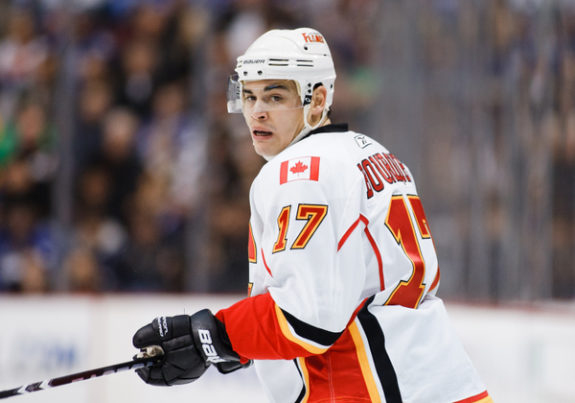
Bourque grew up in a Metis community where hockey equipment was scarce. Interviewed by The Hockey News, Bourque said ‘you see the effects of stuff that goes on in small towns or even in reserves and it’s a tough life for a lot of those kids.’ Bourque says it would be great to see the number of First Nations players in the NHL go up.
Craig Berube
Berube is part Cree and spent 17 years playing in the NHL. He skated for the Flames from early January 1992 until the end of the 1992-93 season, after which the Flames traded him to Washington. He returned to Calgary in the 2001-02 season and ended his NHL career in the city at the end of the next season. At 6-foot-1 and 205 pounds, he was an enforcer throughout his career.
As head coach of the St. Louis Blues in 2019, Berube became the first person of aboriginal descent to coach a team to a Stanley Cup victory.
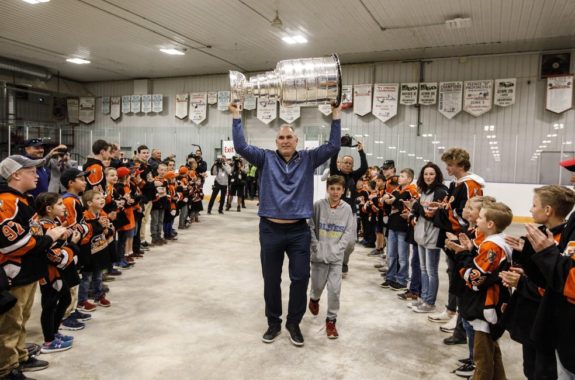
Berube is a regarded role model for First Nations players. In the summer of 2019, he brought the Cup home to Calahoo, Alberta, and dropped by a First Nations community to show off the prize. Band Chief Kurt Burnstick, quoted in a Tweet by the St. Louis Blues, explained on seeing Berube arrive with the Cup that “To see a First Nation person like Craig Berube put his name on that Cup, it means a lot to us.”
Jamie McClennan
Goaltender Jamie McClennan is of unspecified aboriginal ancestry, according to Native Hockey, and played in Calgary for most of two seasons (2002-03 and 2003-04). Nicknamed “Noodles” because he made his own pasta to eat on team bus rides while playing in the minors, he spent a stint on the Flames’ coaching staff in 2008 before moving on in 2009 to become a TSN hockey analyst.
Grant Fuhr
Newspapers used oceans of ink to write about the achievements of Oilers’ goaltending great, Grant Fuhr, over the course of his stellar career. The son of a Cree mother, he’s a member of the Hockey Hall of Fame and earned five Stanley Cup championship rings. In 2017, he was named one of the ‘100 Greatest NHL Players.’ He ended his career in Calgary at the end of the 1999-2000 season.
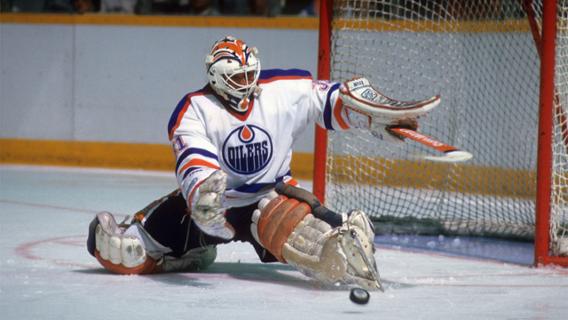
He now lives in Palm Springs and is a fixture on the celebrity golf circuit, raising money for a wide range of charities. He does a great deal of work to support the Arthritis Society of Canada, Lupus Canada and Celebs for Kids.
Stu Grimson
Various native organizations list Grimson as a former NHLer of native ancestry. The 6-foot-6, 240-pound enforcer dubbed the “Grim Reaper” played just four games with Calgary during the 1989-90 season. After his hockey career ended, he went on to become a lawyer and Fox Sports colour commentator covering the Nashville Predators. He lives with his wife and four children in Nashville.
Chris Simon
Born in Wawa, Ontario, Simon’s father was a full-blooded Ojibway from Manitoulin Island. An enforcer, he skated at left-wing for the Flames during the 2003-04 and 2005-06 seasons. Simon has fallen on hard times financially and suffers from chronic traumatic encephalopathy (CTE) linked to head injuries sustained in fights over the course of his hockey career. (from ‘Ex-NHL enforcer Chris Simon files for bankruptcy, court documents say he’s broke,’ Ottawa Citizen, 05/30/2017)
Sandy McCarthy
McCarthy, whose mother was of Mi’Kmaq descent, played with the Flames through almost five seasons from 1993-98. The winger played 735 games over the course of 15 seasons in the NHL.
He now lives in Campbellton, New Brunswick, where he is a coach with the Campbellton Tigers of the Maritime Hockey League.
Mike Peluso
Native Hockey identifies Peluso as being of unspecified indigenous ancestry. The Minnesota-born 6-foot-4, 225-pound enforcer played 23 games as a winger with the Flames in the 1997-98 season. Calgary was his last stop in the NHL before he retired.
Today, Peluso is unable to work, suffers from early-onset dementia, CTE and other severe neurological and psychological problems. He attributes this to constant head trauma suffered in fights over a nine-year stint in the NHL. He brought a lawsuit against the New Jersey Devils seeking compensation for his injuries.
Hope and Inspiration
Nelson Mandela once said, “Sport has the power to change the world. It has the power to inspire. It has the power to unite people in a way that little else does. It speaks to youth in a language they understand. Sport can create hope where once there was despair.”
In Canada, there is too much despair and not enough hope for far too many aboriginal youths. Yet, it is in the stories of the First Nations and Metis hockey players who have proudly worn a Flames sweater that many aboriginal youths in Canada see as symbols of hope. The efforts these players are making to help their young aboriginal brothers and sisters will support Canada’s aboriginal peoples in overcoming the challenges they face and in taking their rightful place in the country.
The Flames and other Canadian franchises, along with the NHL, must find ways to open more opportunities for talented aboriginal hockey players to reach the highest levels in the game they love so much.